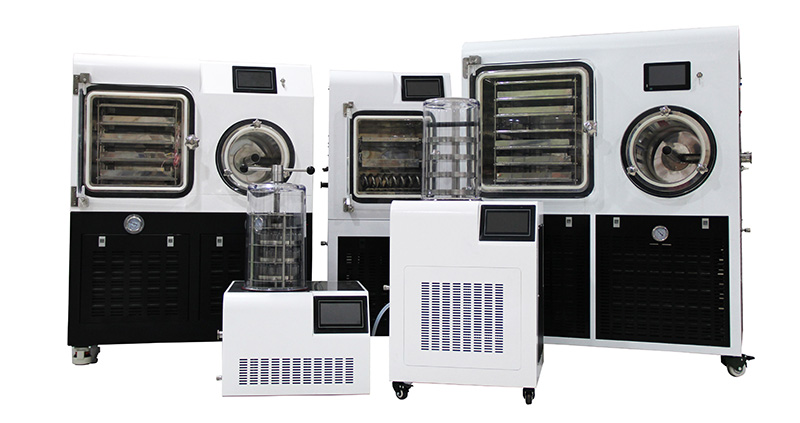1. Principle: A laboratory freeze dryer, also known as a freeze vacuum dryer, is a device that processes liquid or semi-solid samples (such as drugs, food, biological products, etc.) through freezing and vacuum drying techniques. The principle is based on the freeze drying process, which involves freezing the sample at low temperatures and then drying it under low pressure conditions. It mainly includes the following steps:
Freezing: The sample is first frozen into a solid state, usually using liquid nitrogen or refrigerant to lower the sample temperature and prevent the moisture in the sample from converting into ice crystals.
Vacuum: At low temperatures, by creating a vacuum environment, the water in the sample is directly sublimated from solid to gas, bypassing the liquid phase (i.e. reducing the impact of water evaporation on the sample).
Heating up: Under appropriate conditions, gradually increase the temperature of the drying chamber to promote the evaporation of moisture from the gaseous state of the sample.
This process actually removes moisture from the sample without damaging its structure and active ingredients.
2. Application: Laboratory freeze dryers have a wide range of applications in many fields:
Pharmaceutical industry: used for preparing biological products such as drugs, vaccines, proteins, etc. to extend their shelf life and facilitate storage and transportation.
Food industry: used for freeze-drying food, such as coffee, fruits, dairy products, etc., to maintain the taste and flavor of the food.
Biological research: used to preserve microorganisms, cells, enzymes, antibodies, etc. for experimentation and analysis.
Chemical synthesis: used for freeze-drying compounds for long-term storage and transportation.
3. Exploration: In the exploration of laboratory freeze-drying technology, the following aspects can be considered:
Influencing factors: Study the effects of different freeze-drying conditions (temperature, pressure, drying time) on samples to find suitable freeze-drying processes.
Quality analysis: Analyze whether the quality, structure, and activity of the freeze-dried sample are affected.
Comparison: compare the effects of laboratory freeze-drying and other preservation methods (such as freezing, spray drying, etc.), including the preservation time of samples, the quality after recovery, etc.
New application: Explore the potential applications of laboratory freeze-drying technology in new fields, such as new drug development, biomedical engineering, etc.


 Alibaba Store
Alibaba Store Tmall Store
Tmall Store Jingdong Sstore
Jingdong Sstore







